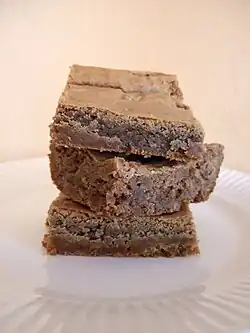 Toffee blondies | |
| Alternative names | Blond[e] brownie, blondie bar, blondies, butterscotch brownie, haole brownies |
|---|---|
| Type | Dessert bar |
| Place of origin | United States |
| Main ingredients | Flour, sugar, butter, eggs, baking powder, vanilla |
A blondie (also known as a blonde brownie) is a variety of dessert bar. It resembles a chocolate brownie, but substitutes vanilla in place of cocoa,[1] and contains brown sugar. Blondies also contain flour, butter, eggs, and baking powder and may also contain walnuts or pecans, white or dark chocolate chips, butterscotch chips, toffee chips, or other flavored chips.[1]
Blondies differ significantly from white chocolate brownies. Unlike the white chocolate brownie or the normal brownie, they contain no chocolate or chocolate flavouring, other than chocolate chips, which may be included. They may also contain coconut, nuts, toffee, or any other chunky candy for added texture. Blondies are not usually frosted; the brown sugar tends to be sweet enough. A variation is the Congo bar, which contains chocolate chips with either walnuts or coconut.
They are baked in a pan in an oven in a manner similar to that of the baking of traditional brownies, then they are cut into rectangular shapes for serving. Blondies are sometimes served in sundaes, often topped with caramel sauce.
History
Blondies existed for at least ten years before chocolate brownies; "dense, fudgy, butterscotch-flavoured bar[s]" existed in the late 19th century, and chocolate brownies were not developed until 1905.[2]
The original name of brownies for these treats came from the elfin characters of brownies that were popular in books and folk stories. It wasn’t until the mid 1970s, or early 1980s that the terms blondie and butterscotch brownies actually seemed to appear.[3]
Blondies were made popular in Hawaii by Kamehameha Schools where they are known as haole brownies.[4] "Haole" is the dynamic translation for "blonde", a characteristic of a white person. But it may be a corruption of the word hāuli, meaning "dark".[5][6][7]
Notes
- 1 2 Process for making brownies containing cellulosic fiber 1988.
- ↑ Cloake, Felicity (24 June 2015). "How to make the perfect blondies". The Guardian. Retrieved 2 September 2019 – via theguardian.com.
- ↑ "The History of Blondies". www.sponge.co.uk. Retrieved 2023-12-12.
- ↑ "National Blonde Brownie Day". KHON2. 23 January 2019.
- ↑ Shimabukuro, Betty (26 April 2000). "Sauce is key to fruit cobbler". archives.starbulletin.com. Honolulu Star-Bulletin.
- ↑ "Nā Puke Wehewehe ʻŌlelo Hawaiʻi-Haole". wehewehe.org.
- ↑ "Nā Puke Wehewehe ʻŌlelo Hawaiʻi-Hauli". wehewehe.org.
References
- A US patent 4774099 A, Robert D. Feeney; Robert L. Prosise & Joseph McGrady et al., "Process for making brownies containing cellulosic fiber", published 27 September 1988, assigned to The Procter & Gamble Company